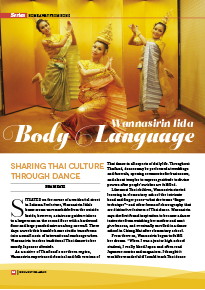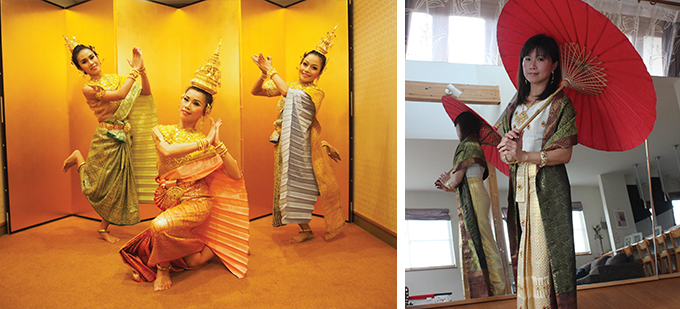Home > Highlighting JAPAN >Highlighting Japan February 2015> Japanese Abroad
Highlighting JAPAN

Home Away From Home
Wannasirin Iida
Body Language

Situated on the corner of a residential street in Saitama Prefecture, Wannasirin Iida’s home seems unremarkable from the outside. Inside, however, a staircase guides visitors to a large room on the second floor with a hardwood floor and large paneled mirrors along one wall. Three days a week this humble home studio transforms into a small oasis of international exchange when Wannasirin teaches traditional Thai dance to her mostly Japanese clientele.
As a native of Thailand’s northern region, Wannasirin experienced classical and folk versions of Thai dance in all aspects of daily life. Throughout Thailand, dances may be performed at weddings and funerals, opening ceremonies for businesses, and also at temples to express gratitude to divine powers after people’s wishes are fulfilled.
Like most Thai children, Wannasirin started learning in elementary school the intricate hand and finger poses—what she terms “finger technique”—and other forms of choreography that are distinctive features of Thai dance. Wannasirin says she first found inspiration to become a dance instructor from watching her mother and aunt give lessons, and eventually enrolled in a dance school in Chiang Mai after elementary school.
From there on, Wannasirin began to fulfill her dream. “When I was a junior high school student, I really liked Japan and often read Japanese comics and magazines. I thought it would be wonderful if I could teach Thai dance in Japan,” she explains. Wannasirin spent three months as a dance student on an exchange program in Japan, learning Japanese language and culture. After graduating from university in 1994, she moved to Japan to teach Thai dance and promote cultural exchange at the Japan-Asia Fine Arts Association
for a year.
Following four years as a Thai dance instructor at an international school in Phuket, Wannasirin returned to Japan in 2000 to study Japanese, and began performing Thai dance at various events from 2001. That became increasingly difficult after she married a Japanese man and gave birth to three children, however.
“After I got married and had kids, I didn’t have as much time for myself as before, so I couldn’t dance as much as I wanted,” Wannasirin recounts. “Nevertheless, I really wanted to dance and teach, and that prompted me to open my own dance school.”
Wannasirin’s studio, called Ban Rabum, opened in 2010, and now hosts approximately a dozen students who commute from Tokyo, Saitama, and as far away as Ibaraki Prefecture. The group includes three young children who are the offspring of Thai and Japanese parents. Wannasirin keeps busy with lessons and performances at cultural events around the Tokyo area, sometimes bringing her students to participate.
Despite her studies, Wannasirin finds that reading and writing Japanese can be tedious, and making preparations for those dance events and cultural festivals time consuming. Still, she says that enjoying life in Japan counterbalances that frustration. “Japan is very clean, and overall an easy place to live,” she notes. Wannasirin also admits to being captivated by Japanese fine arts, saying, “I’ve done some traditional Japanese dance before, and I’d like to try it again.” For her, dance is a language of self-expression which knows no borders.
Having fulfilled her junior high school dream, Wannasirin has greater aspirations in mind. “I want to do more performances of Thai dance, because I’d like more Japanese to know about it,” she says.
© 2009 Cabinet Office, Government of Japan






